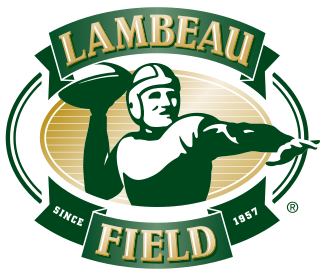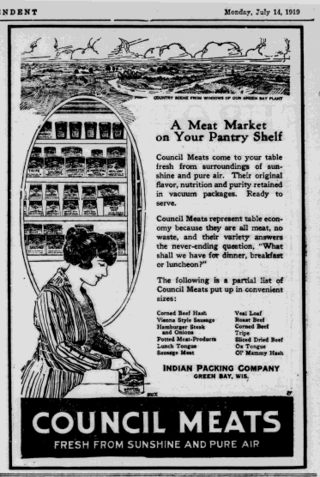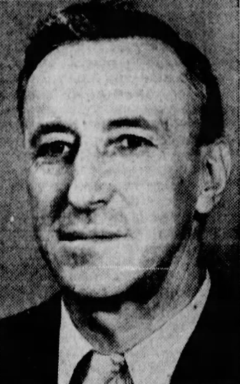
The Green Bay Packers are a professional American football team based in Green Bay, Wisconsin. The Packers compete in the National Football League (NFL) as a member club of the National Football Conference (NFC) North division. It is the third-oldest franchise in the NFL, dating back to 1919, and is the only non-profit, community-owned major league professional sports team based in the United States. Home games have been played at Lambeau Field since 1957. They have the most wins of any NFL franchise.

Earl Louis "Curly" Lambeau was an American professional football player and coach in the National Football League (NFL). Lambeau, along with his friend and fellow Green Bay, Wisconsin, native George Whitney Calhoun, founded the Green Bay Packers in 1919. He served as team captain in the team's first year before becoming player-coach in 1920. As a player, Lambeau lined up as a halfback, which in the early years of the NFL was the premier position. He was the team's primary runner and passer, accounting for 35 touchdowns in 77 games. He won his only NFL championship as a player in 1929.

Lambeau Field is an American football outdoor multi-purpose stadium in Green Bay, Wisconsin. The home field of the Green Bay Packers of the National Football League (NFL), it opened 67 years ago in 1957 as City Stadium, replacing the original City Stadium at Green Bay East High School as the Packers' home field. Informally known as New City Stadium for its first eight seasons, it was renamed in August 1965 in memory of Packers founder, player, and long-time head coach, Earl “Curly” Lambeau, who had died two months earlier.

City Stadium is an American football stadium in Green Bay, Wisconsin, on the north side of the Green Bay East High School property. It was the home of the Green Bay Packers of the NFL from 1925 through 1956. Renovated and downsized, City Stadium remains the home to the adjacent Green Bay East High School athletic teams. Prior to 1925, the Packers played home games at nearby Hagemeister Park and Bellevue Park.

Hagemeister Park was the name of a now defunct park in Green Bay, Wisconsin that was the home of the Green Bay Packers from their founding in 1919 and their first two seasons playing in the National Football League, 1921 and 1922.

George Whitney Calhoun was an American newspaper editor and co-founder of the Green Bay Packers, a professional American football team based in Green Bay, Wisconsin. After establishing the Packers in 1919 with Curly Lambeau, Calhoun served the team in various capacities for 44 years until his death in 1963. Utilizing his editorial job at the Green Bay Press-Gazette, he became the team's first publicity director, helping to establish local support and interest. He also served as the first team manager and was a member of the board of directors of the non-profit corporation that owns the team. Although often overshadowed by the more famous Curly Lambeau, Calhoun was instrumental to the early success of the Packers. In recognition of his contributions, Calhoun was elected to the Green Bay Packers Hall of Fame in 1978.

The Indian Packing Company was a company that was involved in the canned meat industry and was incorporated in Delaware on July 22, 1919. Its canned meat sold as "Council Meats." When the company was absorbed by the Illinois-based Acme Packing Company in 1921, it had facilities in Green Bay, Wisconsin; Providence, Rhode Island; Greenwood, Indiana; and Dupont, Indiana. At the time of the sale it was controlled by New England Supply Company of Providence, Rhode Island, with F.P Comstock as its principal owner.
The 1920 Green Bay Packers season was their second season of competition. Mostly playing other independent professional teams in Wisconsin, the team finished with a 9–1–1 record under player and coach Curly Lambeau.
Adolph E. Kliebhan, sometimes listed as Kliebhahn, was a quarterback in the National Football League (NFL) who played one game for the Green Bay Packers in 1921.

W. Webber Kelly, born William Webber Kelly, was a prominent medical doctor in the state of Wisconsin known for being the third president of the Green Bay Football Corporation, the non-profit organization that owns the Green Bay Packers. Kelly was a practicing physician in Green Bay, Wisconsin, for almost 50 years and a respected civic leader. During his one year as president of the Packers for the 1929 season, the team went 12–0–1 and won its first NFL Championship. Kelly was identified as part of The Hungry Five, a group of Green Bay businessmen who were instrumental in guiding the Packers through multiple financially challenging periods. In addition to his presidency, Kelly served as the team physician from 1921 to 1943 and as a member of the Packers' board of directors from 1923 to 1949. After a falling out with Packers co-founder, head coach, and general manager Curly Lambeau, Kelly resigned from the Board in 1949. Two years later he died of a heart attack at the age of 75. In recognition of his contributions, Kelly was inducted into the Green Bay Packers Hall of Fame in 1994.
The Green Bay East–Green Bay West football rivalry is a high school football rivalry between Green Bay East High School and Green Bay West High School, two public high schools in Green Bay, Wisconsin. Played annually since 1905, it is Wisconsin's longest-running consecutively-played high school football rivalry. The teams first met unofficially in 1895, but did not begin playing annually until ten years later. For much of the early 20th century, the rivalry game was one of the most popular events of the year in Green Bay due to East and West being the only city high schools, drawing crowds that exceeded those of the fledgling Green Bay Packers.

Willard J. Ryan was an American teacher and football coach who served as the first head coach of the Green Bay Packers. Historically, Curly Lambeau has been credited as being the Packers' first head coach, although this is primarily due to the different rules of American football in the early 1900s. In Ryan's era, the head coach was not allowed to communicate with the players while they were playing a game. Lambeau, as team captain, would call the plays during a game and also organized practices, tasks that are now allocated to the head coaching position. Ryan, who also coached the Green Bay West High School football team, only coached the Packers in their inaugural season in 1919, leading the team to a record of . Before his coaching career, Ryan served in World War I in 1918. In 1920, he moved to Minnesota to work as a school teacher and a superintendent of schools. He retired in 1955 and moved to Phoenix, Arizona, in 1961. He died of unknown causes on February 7, 1962, at the age of 71.

Joseph Merrill Hoeffel was an American football player and coach who served as head coach of the Green Bay Packers in 1921. Historically, Curly Lambeau has been credited as being the Packers' that year, although this is primarily due to the different rules of American football in the early 1900s. In Hoeffel's era, the head coach was not allowed to communicate with the players while they were playing a game. Lambeau, as team captain, would call the plays during a game and also organized practices, tasks that are now allocated to the head coaching position.

Frank John Jonet was an American accountant known for serving as the secretary-treasurer of the Green Bay Packers. Jonet graduated from State Teachers College in Wisconsin and taught for 14 years. Professionally, he was a trained accountant who worked for various businesses and was the treasurer for the city of Green Bay, Wisconsin. Associated with the Packers from his time with the Indian Packing Company in 1919 and 1920, Jonet would maintain some link with the team for the next 32 years. In 1933, Jonet was named the receiver for the Packers after the team experienced severe financial issues and entered bankruptcy. After reorganizing to Green Bay Packers, Inc. in 1935 and raising funds through a stock sale, the Packers were saved from folding as an organization. That year, Jonet was named the treasurer for the Packers. In 1941 his title was changed to secretary-treasurer and in 1947 he was elected to the team's board of directors, which he would serve on until his death in 1951. In 2011, Jonet was inducted into the Green Bay Packers Hall of Fame.











